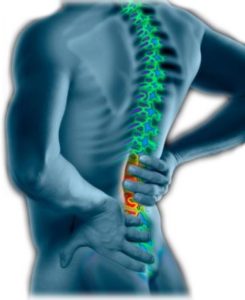 Low back pain (LBP) is the most common musculoskeletal problem within modern society and is associated with massive costs both individually and to the community. Not just in terms of the monetary strain but also the quality of life of those affected. Although the majority of acute LBP episodes tend to improve after one month, there is a section of the population where pain will persist over the three month and even 1 year period. Whilst the risk factors associated with back pain are multifactorial, research has shown that the presence of misconceptions about the condition can have a massive impact on a person’s likelihood of poor rehabilitation. These negative beliefs can stem from a number of places, such as the media, advertising, friends and family, or even health professionals themselves. So to effectively build a healthier attitude towards back pain, here are some of the more common myths surrounding low back pain.
Low back pain (LBP) is the most common musculoskeletal problem within modern society and is associated with massive costs both individually and to the community. Not just in terms of the monetary strain but also the quality of life of those affected. Although the majority of acute LBP episodes tend to improve after one month, there is a section of the population where pain will persist over the three month and even 1 year period. Whilst the risk factors associated with back pain are multifactorial, research has shown that the presence of misconceptions about the condition can have a massive impact on a person’s likelihood of poor rehabilitation. These negative beliefs can stem from a number of places, such as the media, advertising, friends and family, or even health professionals themselves. So to effectively build a healthier attitude towards back pain, here are some of the more common myths surrounding low back pain.
More pain equals more damage
Pain is an extremely complex process that involves ‘potential’ tissue damage but it should also be seen as a sensitivity to noxious stimuli rather than actual injury. Stress and low mood can affect back pain, as can poor sleep, yet the tissues originally involved will be no worse off. Therefore, pain is not an accurate measure of tissue health and low back pain that worsens does not mean that you are doing more damage to the structures involved.
Back pain is caused by something being ‘out of place’
There are always stories of patients and health professionals claiming that a person’s back is ‘out’ or ‘misaligned’. There is overwhelming evidence that structural asymmetries are part and parcel of normal variation. The body is extremely adaptable and resilient and pigeon-holing something as being ‘out of place’ is overly simplistic, not taking in to account other facets that can influence pain.
If you have back pain it is necessary to get a scan
This is one of the more common myths surrounding back pain. A proportion of the population believe that by getting a scan or X-Ray, they will always be able to identify the cause of their back pain. Whilst this is true in some cases, research shows that there is a very poor correlation between what is found on MRI, CT scan or X-Ray and the pain that a person is experiencing. For example, a patient may present to the physio showing disc bulges on CT scan. In reality a large proportion of people over the age of 40 will have similar findings yet experience no back pain. A lot of the time all we are seeing is normal age related changes, and whether the imaging is done or not, the management will follow a similar path.
Back pain is uncommon and something to fear
Incorrect. 80% of people will experience back pain in their lifetime
Avoiding moving and lifting are the best way to manage back pain
Long periods spent lying in bed have been shown to be an ineffective rehabilitation approach for low back pain. A progressive exercise program to build both mobility, control and strength is shown to reduce time spent in pain and return to full function more effectively. Often being overprotective of your back is the best way to make things worse.
Surgery is needed for long term back pain
Although there are some cases where people with long-term low back pain do benefit from surgical intervention, research currently shows no clear benefit compared to a more conservative approach of physiotherapy and exercise rehabilitation. Conservative treatment in comparison to surgical intervention also tends to have a lower risk of side effects.
You must maintain a perfect posture when sitting –
Varying posture in a relaxed and confident way is more beneficial than trying to maintain an unrealistic goal of ‘perfect posture’.
Persistent back pain cannot improve
There are cases where back pain persists but a combined approach focusing on improving functional outcomes and understanding the stressors of your pain can make healthy changes.
Asking more questions about your back and how pain is moderated is key to breaking down harmful misnomers. If you have any further queries please contact the physios at In Balance Physio & Pilates.
Article by Kieran Watson
